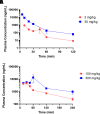Biodistribution of Agmatine to Brain and Spinal Cord after Systemic Delivery
- PMID: 37770201
- PMCID: PMC10658908
- DOI: 10.1124/jpet.123.001828
Biodistribution of Agmatine to Brain and Spinal Cord after Systemic Delivery
Abstract
Agmatine, an endogenous polyamine, has been shown to reduce chronic pain behaviors in animal models and in patients. This reduction is due to inhibition of the GluN2B subunit of the N-methyl-D-aspartate receptor (NMDAR) in the central nervous system (CNS). The mechanism of action requires central activity, but the extent to which agmatine crosses biologic barriers such as the blood-brain barrier (BBB) and intestinal epithelium is incompletely understood. Determination of agmatine distribution is limited by analytical protocols with low sensitivity and/or inefficient preparation. This study validated a novel bioanalytical protocol using high-performance liquid chromatography tandem mass spectrometry (HPLC-MS/MS) for quantification of agmatine in rat biologic matrices. These protocols were then used to determine the plasma pharmacokinetics of agmatine and the extent of distribution to the CNS. Precision and accuracy of the protocol met US Food and Drug Administration (FDA) standards in surrogate matrix as well as in corrected concentrations in appropriate matrices. The protocol also adequately withstood stability and dilution conditions. Upon application of this protocol to pharmacokinetic study, intravenous agmatine showed a half-life in plasma ranging between 18.9 and 14.9 minutes. Oral administration led to a prolonged plasma half-life (74.4-117 minutes), suggesting flip-flop kinetics, with bioavailability determined to be 29%-35%. Intravenous administration led to a rapid increase in agmatine concentration in brain but a delayed distribution and lower concentrations in spinal cord. However, half-life of agmatine in both tissues is substantially longer than in plasma. These data suggest that agmatine adequately crosses biologic barriers in rat and that brain and spinal cord pharmacokinetics can be functionally distinct. SIGNIFICANCE STATEMENT: Agmatine has been shown to be an effective nonopioid therapy for chronic pain, a significantly unmet medical necessity. Here, using a novel bioanalytical protocol for quantification of agmatine, we present the plasma pharmacokinetics and the first report of agmatine oral bioavailability as well as variable pharmacokinetics across different central nervous system tissues. These data provide a distributional rationale for the pharmacological effects of agmatine as well as new evidence for kinetic differences between brain and spinal cord.
Copyright © 2023 by The American Society for Pharmacology and Experimental Therapeutics.
Figures



Similar articles
-
Agmatine preferentially antagonizes GluN2B-containing N-methyl-d-aspartate receptors in spinal cord.J Neurophysiol. 2019 Feb 1;121(2):662-671. doi: 10.1152/jn.00172.2018. Epub 2018 Nov 14. J Neurophysiol. 2019. PMID: 30427758 Free PMC article.
-
Pharmacodynamic and pharmacokinetic studies of agmatine after spinal administration in the mouse.J Pharmacol Exp Ther. 2005 Sep;314(3):1226-33. doi: 10.1124/jpet.105.086173. Epub 2005 Jun 2. J Pharmacol Exp Ther. 2005. PMID: 15933157
-
[Concentration of endogenous agmatine in normal and injured spinal cord: experiment with rats].Zhonghua Yi Xue Za Zhi. 2007 Oct 9;87(37):2649-52. Zhonghua Yi Xue Za Zhi. 2007. PMID: 18162156 Chinese.
-
Neuropharmacokinetic and dynamic studies of agmatine (decarboxylated arginine).Ann N Y Acad Sci. 2003 Dec;1009:82-105. doi: 10.1196/annals.1304.009. Ann N Y Acad Sci. 2003. PMID: 15028573 Review.
-
Neuroprotective offerings by agmatine.Neurotoxicology. 2019 Jul;73:228-245. doi: 10.1016/j.neuro.2019.05.001. Epub 2019 May 4. Neurotoxicology. 2019. PMID: 31063707 Review.
Cited by
-
Agmatine Mitigates Diabetes-Related Memory Loss in Female Mice by Targeting I2/I3 Imidazoline Receptors and Enhancing Brain Antioxidant Defenses.Antioxidants (Basel). 2025 Jul 8;14(7):837. doi: 10.3390/antiox14070837. Antioxidants (Basel). 2025. PMID: 40722940 Free PMC article.
-
Altered Arginine/Agmatine Pathway and Polyamines in Adolescents Diagnosed with Major Depressive Disorder.Clin Psychopharmacol Neurosci. 2024 Nov 30;22(4):624-634. doi: 10.9758/cpn.24.1176. Epub 2024 May 23. Clin Psychopharmacol Neurosci. 2024. PMID: 39420609 Free PMC article.
References
-
- Barron S, Mulholland PJ, Littleton JM, Prendergast MA (2008) Age and gender differences in response to neonatal ethanol withdrawal and polyamine challenge in organotypic hippocampal cultures. Alcohol Clin Exp Res 32:929–936. - PubMed
-
- Courteix C, Privat AM, Pélissier T, Hernandez A, Eschalier A, Fialip J (2007) Agmatine induces antihyperalgesic effects in diabetic rats and a superadditive interaction with R(-)-3-(2-carboxypiperazine-4-yl)-propyl-1-phosphonic acid, a N-methyl-D-aspartate-receptor antagonist. J Pharmacol Exp Ther 322:1237–1245. - PubMed
Publication types
MeSH terms
Substances
Grants and funding
LinkOut - more resources
Full Text Sources
Medical
Miscellaneous

